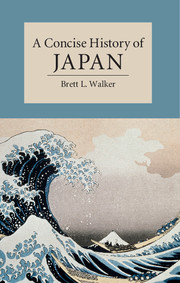Book contents
- Frontmatter
- Dedication
- Contents
- List of Illustrations
- List of Maps
- Preface
- Chronology
- Introduction
- 1 The Birth of the Yamato State, 14,500 bce – 710 ce
- 2 The Courtly Age, 710–1185
- 3 The Rise of Samurai Rule, 1185–1336
- 4 Medieval Japan and the Warring States Period, 1336–1573
- 5 Japan’s Encounter with Europe, 1543–1640
- 6 Unifying the Realm, 1560–1603
- 7 Early Modern Japan, 1600–1800
- 8 The Rise of Imperial Nationalism, 1770–1854
- 9 Meiji Enlightenment, 1868–1912
- 10 Meiji’s Discontents, 1868–1920
- 11 The Birth of Japan’s Imperial State, 1800–1910
- 12 Empire and Imperial Democracy, 1905–1931
- 13 The Pacific War, 1931–1945
- 14 Japan’s Post-War History, 1945–Present
- 15 Natural Disasters and the Edge of History
- Glossary
- Further Reading
- Index
8 - The Rise of Imperial Nationalism, 1770–1854
Published online by Cambridge University Press: 05 March 2015
- Frontmatter
- Dedication
- Contents
- List of Illustrations
- List of Maps
- Preface
- Chronology
- Introduction
- 1 The Birth of the Yamato State, 14,500 bce – 710 ce
- 2 The Courtly Age, 710–1185
- 3 The Rise of Samurai Rule, 1185–1336
- 4 Medieval Japan and the Warring States Period, 1336–1573
- 5 Japan’s Encounter with Europe, 1543–1640
- 6 Unifying the Realm, 1560–1603
- 7 Early Modern Japan, 1600–1800
- 8 The Rise of Imperial Nationalism, 1770–1854
- 9 Meiji Enlightenment, 1868–1912
- 10 Meiji’s Discontents, 1868–1920
- 11 The Birth of Japan’s Imperial State, 1800–1910
- 12 Empire and Imperial Democracy, 1905–1931
- 13 The Pacific War, 1931–1945
- 14 Japan’s Post-War History, 1945–Present
- 15 Natural Disasters and the Edge of History
- Glossary
- Further Reading
- Index
Summary
The Tokugawa Peace endured for well over two centuries. Early on, however, cracks began to disfigure the edifice of Tokugawa rule. Over time, these cracks expanded and branched out into a complex web of problems that toppled the Edo bakufu in the mid-nineteenth century, ending centuries of samurai rule in Japan. Some of these problems were domestic in nature and included peasant uprisings, disparities between merchant wealth and samurai poverty, bizarre examples of urban millenarianism, and ideological challenges calling for a return to imperial rule. These domestic problems were compounded by external ones, which included Russian encroachment in the North Pacific and the arrival of US Commodore Matthew C. Perry (1794–1858) and his smoke-belching ‘black ships’ in 1853. Together, these domestic and international forces overburdened the Edo bakufu and it collapsed in 1868 in a relatively brief conflict called the Boshin War (1868–9).
Cracks in Tokugawa Legitimacy
Some 2,809 different instances of peasant rebellion occurred during the early modern period, in forms ranging from ‘direct petition’ and violent ‘collective action’ to ‘smash and break’ and ‘world renewal’. Though most peasant rebellions occurred for reasons more economic than political – that is, they sought to smash the houses of local wealthy merchants or peasants who had profited from the vibrant cash-crop economy – some rebellions proved politically subversive and carried aspirations of regime change. An implicit ‘moral economy’ existed in the Neo-Confucian orthodoxy of the early modern years, assuring that ‘honourable peasants’ were treated fairly by ‘benevolent lords’. When domain lords squeezed peasants too hard, as Sakura Sôgorô (d. 1653) and others in Narita experienced in the seventeenth century, they directly petitioned domain lords and, in the case of Sôgorô, even the shogun, to alleviate some of the economic hardships in their villages. They believed they were entitled to live. ‘In fear and trembling we respectfully present our statement in writing’, explained the petition that Sôgorô delivered in dramatic form to the shogun in Edo.
- Type
- Chapter
- Information
- A Concise History of Japan , pp. 143 - 158Publisher: Cambridge University PressPrint publication year: 2015



